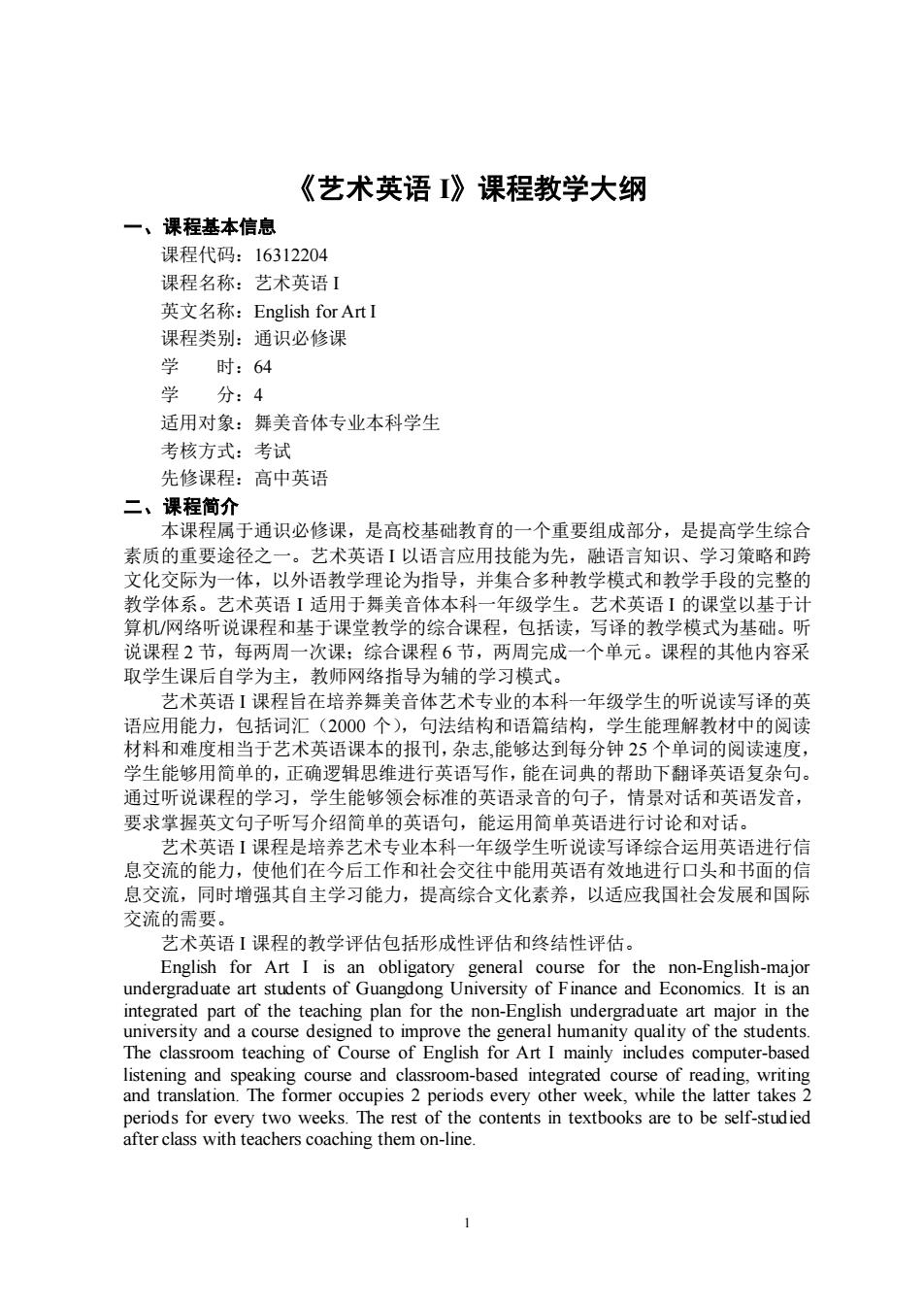
《艺术英语》课程教学大纲 一、课程基本信息 课程代码:16312204 课程名称:艺术英语 英文名称:English for Art I 课程类别:通识必修课 学 时:64 学 分:4 适用对象:舞美音体专业本科学生 考核方式:考试 先修课程:高中英语 二、课程简介 本课程属于通识必修课,是高校基础教育的一个重要组成部分,是提高学生综合 素质的重要途径之一。艺术英语!以语言应用技能为先,融语言知识、学习策略和跨 文化交际为一体,以外语教学理论为指导,并集合多种教学模式和教学手段的完整的 教学体系。艺术英语1适用于舞美音体本科一年级学生 艺术英语的课堂以基于计 算机 网络 说课稻 课堂 教 综合课程,包括读, 为 基础 说课程2节,每两周一次课:综合课程6节,两周完成一个单元。课程的其他内容采 取学生课后自学为主,教师网络指导为辅的学习模式。 艺术英语1课程旨在培养舞美音体艺术专业的本科一年级学生的听说读写译的英 语应用能力,包括词汇(2000个),句法结构和语篇结构,学生能理解教材中的阅读 材料和难度相当于艺术英语课本的 报刊 能够达 每分钟25 的阅 速度 学生能够用简单的,正确逻辑思维进行英语写作,能在词典的帮助下翻译英语复杂句。 通过听说课程的学习,学生能够领会标准的英语录音的句子,情景对话和英语发音, 要求草堂握英文句子听写介绍简单的英语句,能运用简单英语讲行讨论和对话。 梦术茧语1课程是培养梦术专业本科 一年级学生听说读写译综合运用英语进行信 自流的能力 使他们在今后工作和社会交往中能用英 有效地进行口头和书面的信 息交流,同时增强其自主学习能力,提高综合文化素养,以适应我国社会发展和国际 交流的需要。 艺术英语1课程的教学评估包括形成性评估和终结性评估。 English for Art I is an obligator neral course for the non-English-maior undergraduate art students of Guangdong University of Finance and Economics.It is an integrated part of the teaching plan for the non-English undergraduate art major in the university and a course designed to improve the general humanity quality of the students The classroom teaching of Course of English for Art I mainly includes computer-based listening and speaking course and classroom-based integrated course of reading,writing and translation.The former occupies 2 periods every other week,while the latter takes e teok re tobe
1 《艺术英语 I》课程教学大纲 一、课程基本信息 课程代码:16312204 课程名称:艺术英语 I 英文名称:English for Art I 课程类别:通识必修课 学 时:64 学 分:4 适用对象:舞美音体专业本科学生 考核方式:考试 先修课程:高中英语 二、课程简介 本课程属于通识必修课,是高校基础教育的一个重要组成部分,是提高学生综合 素质的重要途径之一。艺术英语 I 以语言应用技能为先,融语言知识、学习策略和跨 文化交际为一体,以外语教学理论为指导,并集合多种教学模式和教学手段的完整的 教学体系。艺术英语 I 适用于舞美音体本科一年级学生。艺术英语 I 的课堂以基于计 算机/网络听说课程和基于课堂教学的综合课程,包括读,写译的教学模式为基础。听 说课程 2 节,每两周一次课;综合课程 6 节,两周完成一个单元。课程的其他内容采 取学生课后自学为主,教师网络指导为辅的学习模式。 艺术英语 I 课程旨在培养舞美音体艺术专业的本科一年级学生的听说读写译的英 语应用能力,包括词汇(2000 个),句法结构和语篇结构,学生能理解教材中的阅读 材料和难度相当于艺术英语课本的报刊,杂志,能够达到每分钟 25 个单词的阅读速度, 学生能够用简单的,正确逻辑思维进行英语写作,能在词典的帮助下翻译英语复杂句。 通过听说课程的学习,学生能够领会标准的英语录音的句子,情景对话和英语发音, 要求掌握英文句子听写介绍简单的英语句,能运用简单英语进行讨论和对话。 艺术英语 I 课程是培养艺术专业本科一年级学生听说读写译综合运用英语进行信 息交流的能力,使他们在今后工作和社会交往中能用英语有效地进行口头和书面的信 息交流,同时增强其自主学习能力,提高综合文化素养,以适应我国社会发展和国际 交流的需要。 艺术英语 I 课程的教学评估包括形成性评估和终结性评估。 English for Art I is an obligatory general course for the non-English-major undergraduate art students of Guangdong University of Finance and Economics. It is an integrated part of the teaching plan for the non-English undergraduate art major in the university and a course designed to improve the general humanity quality of the students. The classroom teaching of Course of English for Art I mainly includes computer-based listening and speaking course and classroom-based integrated course of reading, writing and translation. The former occupies 2 periods every other week, while the latter takes 2 periods for every two weeks. The rest of the contents in textbooks are to be self-studied after class with teachers coaching them on-line

English for Art I aims to develop students'abilities to leam language clud ing y20 as we d the wit hle to y ith nd to ith multi la the hep with dictionaries Through listening and speaking.students should be able to understand standard recorded english sentences dialog ponounced take dictations on simple English sentences introduce themselves in E and take part in discussions or make dialogues using simple English. English for Art I also aims to develop students'ability to use English in an all-round way so that in their future work and social interactions they will be able to exchange information effectively through both spoken and written channels,and at the same time they will be able to enhance their ability to study independently and improve their cultural quality so as to m eet the ne velopment and inte The evaluation of English for Art I consists of both formative assessment and 三、课程性质与教学目的 艺术英语1级课程是为广东财经大学非英语专业的艺术类专业本科一年级学生开 设的一门语言技能基础课程,是广东财经大学非英语专业教学计划的一个有机组成部 分,是一门提高艺术专业学生综合人文素养的重要课程。 艺术英语1级课程的学习,既是学生通过英语学习和实践活动逐步学握英语知识 和技能,提高语言实际运用能力的过程,又是他们陶治情操, 丰富人生经验,开发辩 证思维能力和提高人文素养的过程。它有助于学生拓展视野,扩大知识面,加深对世 界的了解,借鉴和吸收优秀的外国文化精华,提高文化素养。艺术英语Ⅱ课程是以英 语语言知识与应用技巧,学习策略和跨文化交际为主要内容,以外语教学理论为指导, 并集多种教学模式和教学手段为一体的教学体系 艺术英语1级课程教学目的是:通过教师的“精讲”和学生的“多练”通过听说 读写译全方位的各种形式的课堂内外的实践,以多媒体技术为教学手段之一,培养学 生的阅读能力和听说能力,使他们能够运用英语交流信息,打下扎实的语言基础,掌 握良好的语言学习方法,提高文化素养,培养持续的自学能力,适应社会的需求和发 展。 艺术英语1级课程目标是能听懂发音清晰,节奏缓慢,语音标准的录音句子,熟 悉话题的录音短文,能够听懂用简单英语进行的课堂讨论,能借助视频和字幕听懂电 影对白的主要意思。能用简单的英语口头描述人物,个人经历,朋友交往,生活学习 场景,日常事物,个人喜好,能在课堂讨论中用英语发表自己的简单见解,能读懂和 艺术英语Ⅱ级相当难度的英文报刊和杂志。能用简单连贯的英语书面表达熟悉题材的 内容,能写出故事连贯的记叙文(50词左右)。能多渠道获取英语信息,能体会视 听材料和书面材料中的跨文化信息
2 English for Art I aims to develop students’ abilities to learn corresponding language and pragmatic skills including Vocabulary (2000 words).syntactic structures as well as textual structures, to understand the reading materials as well as English newspapers and magazines with the similar degree of difficulty to those passages in the textbooks at a speed of 25 words per minute, be able to write simple English sentences with correct grammar and proper logic, and to translate English sentences with multiple clauses into Chinese and vice versa, with the help with dictionaries. Through listening and speaking, students should be able to understand standard recorded English sentences, dialogues and speeches pronounced, take dictations on simple English sentences, introduce themselves in English, and take part in discussions or make dialogues using simple English. English for Art I also aims to develop students’ ability to use English in an all-round way so that in their future work and social interactions they will be able to exchange information effectively through both spoken and written channels, and at the same time they will be able to enhance their ability to study independently and improve their cultural quality so as to meet the needs of China’s social development and international exchanges. The evaluation of English for Art I consists of both formative assessment and summative assessment. 三、课程性质与教学目的 艺术英语 I 级课程是为广东财经大学非英语专业的艺术类专业本科一年级学生开 设的一门语言技能基础课程,是广东财经大学非英语专业教学计划的一个有机组成部 分,是一门提高艺术专业学生综合人文素养的重要课程。 艺术英语 I 级课程的学习,既是学生通过英语学习和实践活动逐步掌握英语知识 和技能,提高语言实际运用能力的过程,又是他们陶冶情操,丰富人生经验,开发辩 证思维能力和提高人文素养的过程。它有助于学生拓展视野,扩大知识面,加深对世 界的了解,借鉴和吸收优秀的外国文化精华,提高文化素养。艺术英语 II 课程是以英 语语言知识与应用技巧,学习策略和跨文化交际为主要内容,以外语教学理论为指导, 并集多种教学模式和教学手段为一体的教学体系。 艺术英语 I 级课程教学目的是:通过教师的“精讲”和学生的“多练”通过听说 读写译全方位的各种形式的课堂内外的实践,以多媒体技术为教学手段之一,培养学 生的阅读能力和听说能力,使他们能够运用英语交流信息,打下扎实的语言基础,掌 握良好的语言学习方法,提高文化素养,培养持续的自学能力,适应社会的需求和发 展。 艺术英语 I 级课程目标是能听懂发音清晰,节奏缓慢,语音标准的录音句子,熟 悉话题的录音短文,能够听懂用简单英语进行的课堂讨论,能借助视频和字幕听懂电 影对白的主要意思。能用简单的英语口头描述人物,个人经历,朋友交往,生活学习 场景,日常事物,个人喜好,能在课堂讨论中用英语发表自己的简单见解,能读懂和 艺术英语 II 级相当难度的英文报刊和杂志。能用简单连贯的英语书面表达熟悉题材的 内容,能写出故事连贯的记叙文 (50 词左右)。能多渠道获取英语信息,能体会视 听材料和书面材料中的跨文化信息

学会辨析中西方艺术文化对比,培养中华民族自信,加强爱国主义教育,树立正 确世界观和价值观。 四、教学内容及要求 精读部分 Unit I (一)目的与要求 Students are expected to 1.understand the main idea of text a and B.learn to know about the mental states and issues of the freshmen on campus. 2.master the key worlds and expressions and sentences patterns (the negative sentences,sentence of real condition,and sentence of question). 3.grasp the different pronunciation of short vowel[i]and long vowel [i:] 4.appreciate the profound influence of Chinese cultures and deep thoughts of Confucius (二)教学内容 1.主要内容 1)Text A Your first night at school. 2)Warm-up Activities(Matching and Conversation) 3)TextA 4)Background information(SAT,NCAA) 5)language Points 6)Suggested Questions 7)Additional Materials 8)After class reading:Text B Never too old to live up your dreams? 2.基本概念和知识点 1)Key words(dormitory,gymnasium,library,classroom building.canteen,lecture hall) 2)Language Points a.Survive:(Idon't think I could survive another year as a teacher,it's just too stressful.) b.It'sa little weird,isn'tit?(反义疑问句强调句子的前半句) c.Social:(The social we attended last night was very successful.) d.The first week is going to be a whirlwind,but take advantage of the energy while you have it..(这是一个并列复合句,前一个分句用了一个隐喻,后一个分句是 个祈使句。) 3
3 学会辨析中西方艺术文化对比,培养中华民族自信,加强爱国主义教育,树立正 确世界观和价值观。 四、教学内容及要求 精读部分 Unit 1 (一)目的与要求 Students are expected to 1. understand the main idea of text A and B, learn to know about the mental states and issues of the freshmen on campus; 2. master the key worlds and expressions and sentences patterns (the negative sentences, sentence of real condition, and sentence of question); 3. grasp the different pronunciation of short vowel[i]and long vowel [i:]; 4. appreciate the profound influence of Chinese cultures and deep thoughts of Confucius (二)教学内容 1. 主要内容 1) Text A Your first night at school. 2) Warm-up Activities ( Matching and Conversation) 3) Text A 4)Background information (SAT,NCAA) 5) language Points 6) Suggested Questions 7) Additional Materials 8)After class reading : Text B Never too old to live up your dreams? 2. 基本概念和知识点 1) Key words (dormitory, gymnasium, library, classroom building, canteen, lecture hall) 2) Language Points a. Survive: (Idon’t think I could survive another year as a teacher; it’s just too stressful.) b. It’s a little weird, isn’t it? (反义疑问句强调句子的前半句) c. Social: (The social we attended last night was very successful.) d. The first week is going to be a whirlwind, but take advantage of the energy while you have it.(这是一个并列复合句,前一个分句用了一个隐喻,后一个分句是 个祈使句。)

e.lifelong (He's got a lifelong fascination with the sea) 3)Questions answering Is it easy to enter college? How do you feel when you are finally in college? Why should you get good night of sleep on your first night at college? What are the author's suggestions to you for the first week of your college days? How will the next few days be? 4)Writing style and Summary 3.问题与应用(能力要求) 1)Listening and speaking 2)Reading comprehension 3)Analyzing the sentences patterns 4)Writing ability and writing structure 5)Summary 6)Grammar (三)思考与实践 Content Questions(Pair work) Points for Discussions(Group work) Text Organization Language Sense Enhancement Language Focus:Vocabulary:Usage.Structure:clauses,translation Home Reading(Text B)and Exercises Self-assessment listening Listing and Speaking:Home Listening.Speaking Tasks,Pair work (四)教学方法与手段 课堂讲授,课堂讨论,多媒体,网络学习,自主学习 Unit2 (一) 目的与要求 Studentsare expected to 1.understand the main idea of text A and B,leam to know about the musician's high spirits of pursuing perfect. 2.master the key worlds and expressions and sentences patterns: 3.grasp the different pronunciation of vowel[e]and long vowel [e:] 4.learn how to use Nouns properly; 4
4 e. lifelong (He’s got a lifelong fascination with the sea) 3) Questions answering Is it easy to enter college? How do you feel when you are finally in college? Why should you get good night of sleep on your first night at college? What are the author’s suggestions to you for the first week of your college days? How will the next few days be? 4) Writing style and Summary 3. 问题与应用(能力要求) 1) Listening and speaking 2) Reading comprehension 3) Analyzing the sentences patterns 4) Writing ability and writing structure 5) Summary 6) Grammar (三)思考与实践 Content Questions (Pair work) Points for Discussions (Group work) Text Organization Language Sense Enhancement Language Focus: Vocabulary; Usage, Structure; clauses, translation Home Reading (Text B) and Exercises Self-assessment listening Listing and Speaking: Home Listening, Speaking Tasks, Pair work (四)教学方法与手段 课堂讲授,课堂讨论,多媒体,网络学习,自主学习 Unit 2 (一) 目的与要求 Students are expected to 1. understand the main idea of text A and B, learn to know about the musician’s high spirits of pursuing perfect; 2. master the key worlds and expressions and sentences patterns; 3. grasp the different pronunciation of vowel[e]and long vowel [e:]; 4. learn how to use Nouns properly;

5 appreciate the friendships between musicians (二)教学内容 1.主要内容 Text A The Opera Signer 1)Warm-up Activities(Matching and Conversation) 2)TextA 3)Background information (Pedro Pablo Sacristan,History of Opera) 4)language Points 5)Suggested Questions 6)Additional Materials 7)After class reading:Text B Play a Violin with Three String 2.基本概念和知识点 1)Key words(violin,bass,saxophone,cello,flute,dulcimer) 2)Language Points a.matter.(It's no laughing matter.How did matters stand?) b.What made him most unusual,though,was the fact that whenever he needed to communicate he did it by singing opera 这个句子包含一个由what引导的从句做句子的主语和一个由that引导的复合句做 fact的同位语。 c.clear:(He cleared this throat and began singing.) d.It wouldn't be unfair to say that almost everyone considered William Warbler a massive pain in the neck. 这是双重否定表肯定的句子 3)Questions answering What made William Warbler different from others? Did anvone know what william's job was? What clothes did William usually wear? What was the rumor about? Why did William sing while communicating with others? 4)Writing style and Summary 3.问题与应用(能力要求】 1)Listening and speaking 2)Reading comprehensions 3)Analyzing the sentences pattems 4)Writing ability and writing structure 5
5 5. appreciate the friendships between musicians. (二)教学内容 1. 主要内容 Text A The Opera Signer 1) Warm-up Activities ( Matching and Conversation) 2) Text A 3)Background information (Pedro Pablo Sacristan, History of Opera) 4) language Points 5) Suggested Questions 6) Additional Materials 7)After class reading :Text B Play a Violin with Three String 2. 基本概念和知识点 1) Key words (violin, bass, saxophone, cello, flute, dulcimer) 2) Language Points a. matter: (It’s no laughing matter. How did matters stand?) b. What made him most unusual, though, was the fact that whenever he needed to communicate he did it by singing opera. 这个句子包含一个由 what 引导的从句做句子的主语和一个由 that 引导的复合句做 fact 的同位语。 c. clear: (He cleared this throat and began singing.) d. It wouldn’t be unfair to say that almost everyone considered William Warbler a massive pain in the neck. 这是双重否定表肯定的句子。 3) Questions answering What made William Warbler different from others? Did anyone know what William’s job was? What clothes did William usually wear? What was the rumor about? Why did William sing while communicating with others? 4) Writing style and Summary 3.问题与应用(能力要求) 1)Listening and speaking 2)Reading comprehensions 3)Analyzing the sentences patterns 4)Writing ability and writing structure
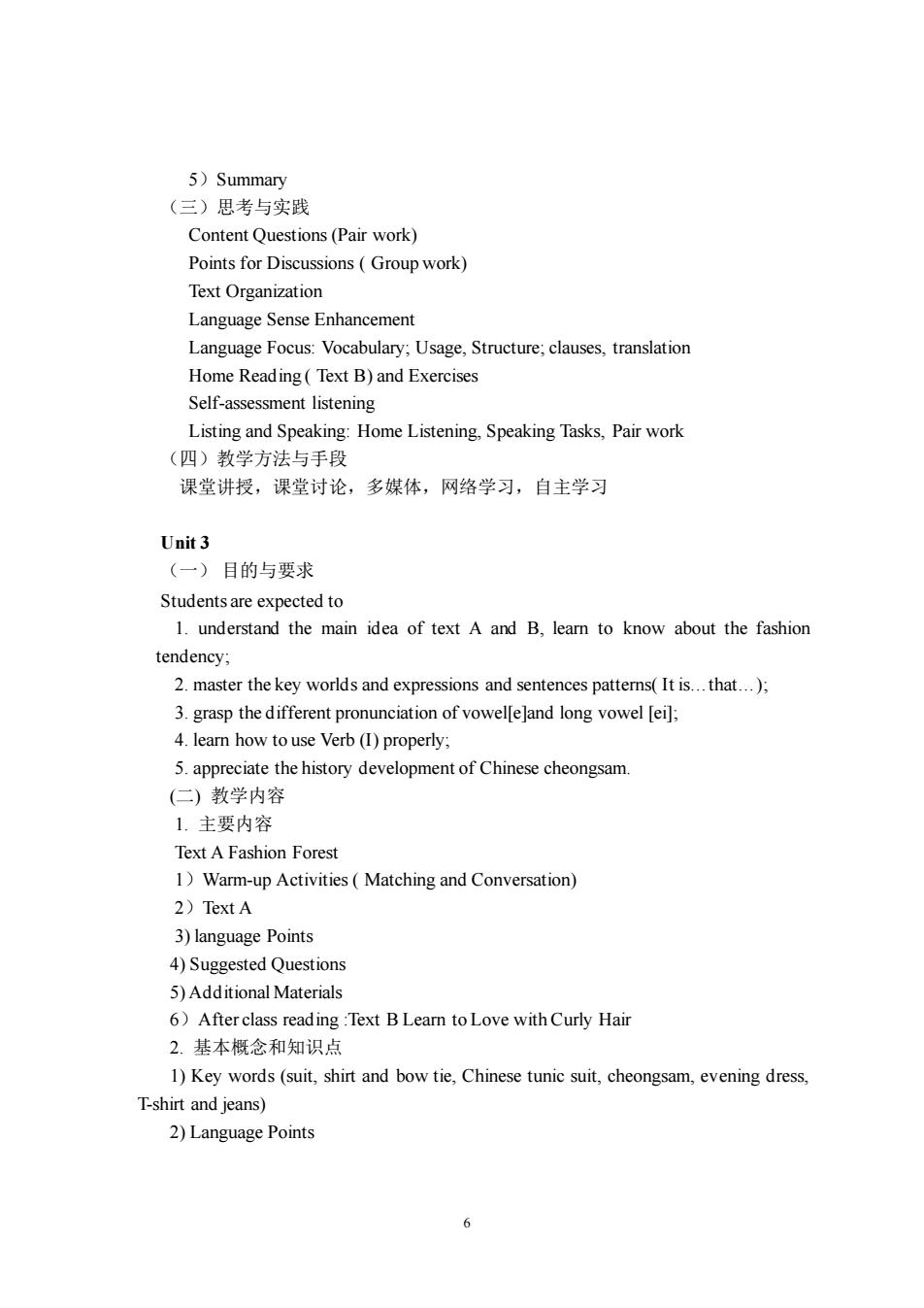
5)Summary (三)思考与实践 Content Questions(Pair work) Points for Discussions(Group work) Text Organization Language Sense Enhancement Language Focus:Vocabulary:Usage,Structure;clauses,translation Home Reading(Text B)and Exercises Self-assessment listening Listing and Speaking:Home Listening.Speaking Tasks,Pair work (四)教学方法与手段 课堂讲授,课堂讨论,多媒体,网络学习,自主学习 Unit3 (一)目的与要求 Students are expected to 1.understand the main idea of text A and B.leam to know about the fashior tendency: 2.master the key worlds and expressions and sentences patters(It is.that.). 3.grasp the different pronunciation of vowel[e]and long vowel [ei]: 4.leam how to use Verb(I)properly. 5.appreciate the history development of Chinese cheongsam. (二)教学内容 1主要内容 Text A Fashion Forest 1)Warm-up Activities(Matching and Conversation) 2)TextA 3)language Points 4)Suggested Questions 5)Additional Materials 6)After class reading:Text B Learn to Love with Curly Hair 2基本概念和知识 1)Key words(suit,shirt and bow tie,Chinese tunic suit,cheongsam,evening dress. I-shirt and jeans) 2)Language Points
6 5)Summary (三)思考与实践 Content Questions (Pair work) Points for Discussions ( Group work) Text Organization Language Sense Enhancement Language Focus: Vocabulary; Usage, Structure; clauses, translation Home Reading ( Text B) and Exercises Self-assessment listening Listing and Speaking: Home Listening, Speaking Tasks, Pair work (四)教学方法与手段 课堂讲授,课堂讨论,多媒体,网络学习,自主学习 Unit 3 (一) 目的与要求 Students are expected to 1. understand the main idea of text A and B, learn to know about the fashion tendency; 2. master the key worlds and expressions and sentences patterns( It is…that…); 3. grasp the different pronunciation of vowel[e]and long vowel [ei]; 4. learn how to use Verb (I) properly; 5. appreciate the history development of Chinese cheongsam. (二) 教学内容 1. 主要内容 Text A Fashion Forest 1)Warm-up Activities ( Matching and Conversation) 2)Text A 3) language Points 4) Suggested Questions 5) Additional Materials 6)After class reading :Text B Learn to Love with Curly Hair 2. 基本概念和知识点 1) Key words (suit, shirt and bow tie, Chinese tunic suit, cheongsam, evening dress, T-shirt and jeans) 2) Language Points
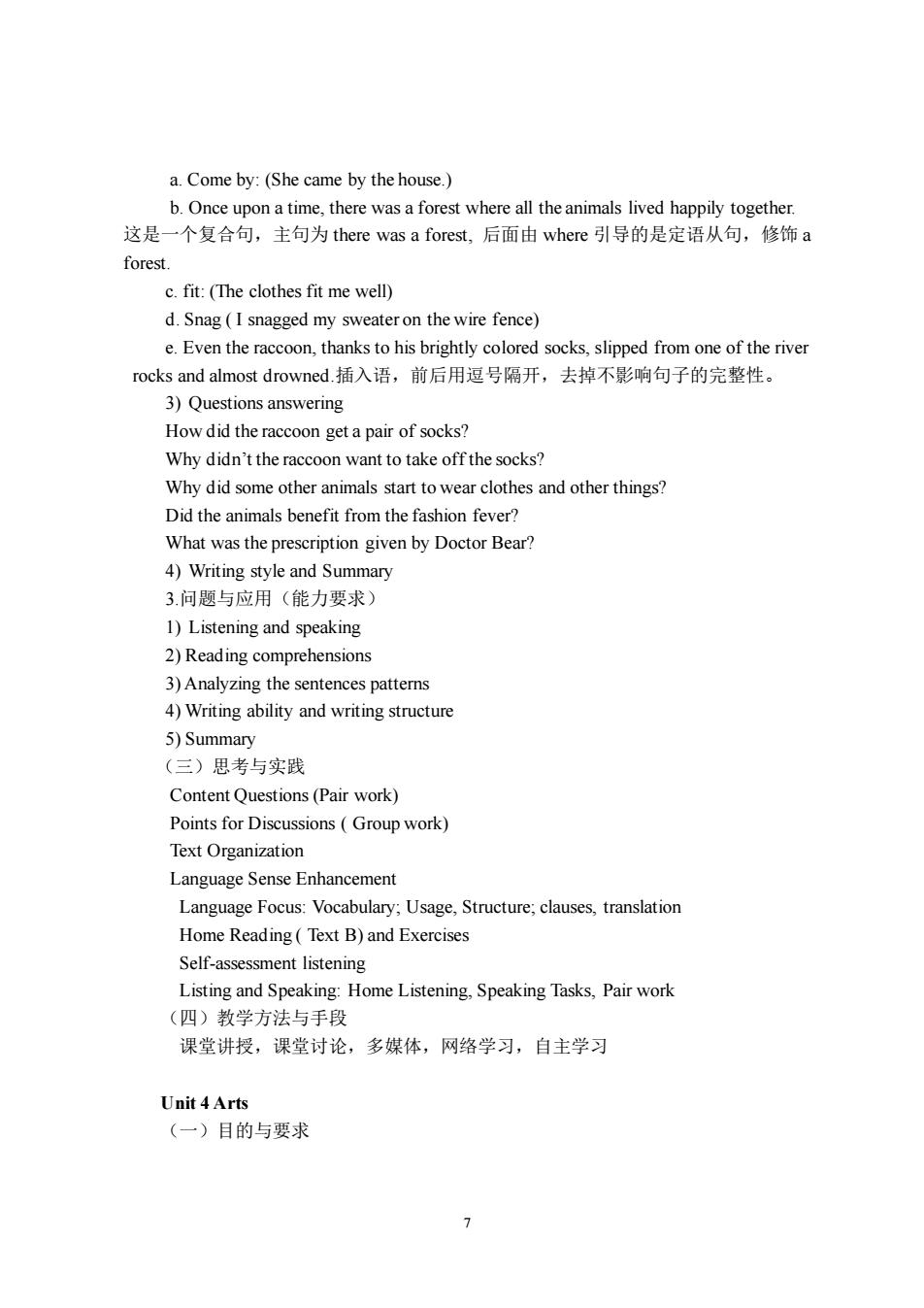
a.Come by:(She came by the house.) b.Once upon a time,there was a forest where all the animals lived happily together. 这是一个复合句,主句为there was a forest,.后面由where引导的是定语从句,修饰a forest. c.fit:(The clothes fit me well) d.Snag (I snagged my sweater on the wire fence) e.Even the raccoon,thanks to his brightly colored socks,slipped from one of the river rocks and almost drowned.插入语,前后用逗号隔开,去掉不影响句子的完整性。 3)Questions answering How did the raccoon get a pair of socks? Why didn't the raccoon want to take offthe socks? Why did some other animals start to wear clothes and other things? Did the animals benefit from the fashion fever? What was the prescription given by Doctor Bear? 4)Writing style and Summary 3.问题与应用(能力要求) 1)Listening and speaking 2)Reading comprehensions 3)Analyzing the sentences patterns 4)Writing ability and writing structure 5)Summary (三)思考与实践 Content Questions(Pair work) Points for Discussions(Group work) Text Organization Language Sense Enhancement Language Focus:Vocabulary;Usage,Structure:clauses,translation Home Reading(Text B)and Exercises Self-assessment listening Listing and Speaking:Home Listening,Speaking Tasks,Pair work (四)教学方法与手段 课堂讲授,课堂讨论,多媒体,网络学习,自主学习 Unit4Arts (一)目的与要求
7 a. Come by: (She came by the house.) b. Once upon a time, there was a forest where all the animals lived happily together. 这是一个复合句,主句为 there was a forest, 后面由 where 引导的是定语从句,修饰 a forest. c. fit: (The clothes fit me well) d. Snag ( I snagged my sweater on the wire fence) e. Even the raccoon, thanks to his brightly colored socks, slipped from one of the river rocks and almost drowned.插入语,前后用逗号隔开,去掉不影响句子的完整性。 3) Questions answering How did the raccoon get a pair of socks? Why didn’t the raccoon want to take off the socks? Why did some other animals start to wear clothes and other things? Did the animals benefit from the fashion fever? What was the prescription given by Doctor Bear? 4) Writing style and Summary 3.问题与应用(能力要求) 1) Listening and speaking 2) Reading comprehensions 3) Analyzing the sentences patterns 4) Writing ability and writing structure 5) Summary (三)思考与实践 Content Questions (Pair work) Points for Discussions ( Group work) Text Organization Language Sense Enhancement Language Focus: Vocabulary; Usage, Structure; clauses, translation Home Reading ( Text B) and Exercises Self-assessment listening Listing and Speaking: Home Listening, Speaking Tasks, Pair work (四)教学方法与手段 课堂讲授,课堂讨论,多媒体,网络学习,自主学习 Unit 4 Arts (一)目的与要求
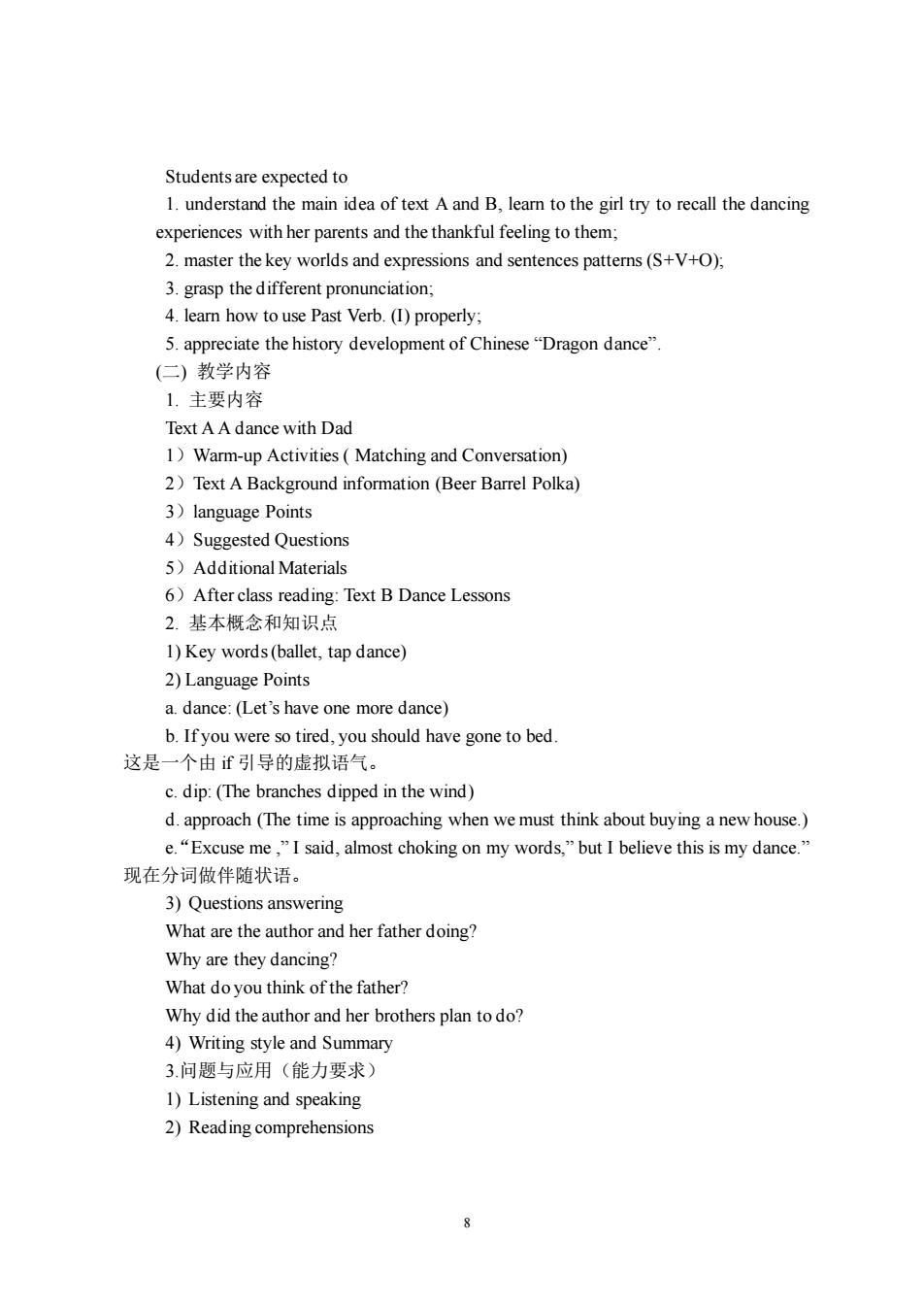
Students are expected to 1.understand the main idea of text A and B.leamn to the girl try to recall the dancing experiences with her parents and the thankful feeling to them: 2.master the key worlds and expressions and sentences pattems(S+V+O) 3.grasp the different pronunciation; 4.leam how to use Past Verb.(I)properly 5.appreciate the history development of Chinese"Dragon dance" (二)教学内容 1.主要内容 Text AA dance with Dad 1)Warm-up Activities(Matching and Conversation) 2)Text A Background information(Beer Barrel Polka) 3)language Points 4)Suggested Questions 5)Additional Materials 6After class reading:Text B Dance Lessons 2.基本概念和知识点 1)Key words(ballet,tap dance) 2)Language Points a.dance:(Let's have one more dance) b.Ifyou were so tired,you should have gone to bed. 这是一个由f引导的虚拟语气。 c.dip:(The branches dipped in the wind) d.approach (The time is approaching when we must think about buying a new house.) e."Excuse me,"I said,almost choking on my words,"but I believe this is my dance." 现在分词做伴随状语。 3)Questions answering What are the author and her father doing? Why are they dancing? What do you think of the father? Why did the author and her brothers plan to do? 4)Writing style and Summary 3.问题与应用(能力要求) 1)Listening and speaking 2)Reading comprehensions
8 Students are expected to 1. understand the main idea of text A and B, learn to the girl try to recall the dancing experiences with her parents and the thankful feeling to them; 2. master the key worlds and expressions and sentences patterns (S+V+O); 3. grasp the different pronunciation; 4. learn how to use Past Verb. (I) properly; 5. appreciate the history development of Chinese “Dragon dance”. (二) 教学内容 1. 主要内容 Text A A dance with Dad 1)Warm-up Activities ( Matching and Conversation) 2)Text A Background information (Beer Barrel Polka) 3)language Points 4)Suggested Questions 5)Additional Materials 6)After class reading: Text B Dance Lessons 2. 基本概念和知识点 1) Key words (ballet, tap dance) 2) Language Points a. dance: (Let’s have one more dance) b. If you were so tired, you should have gone to bed. 这是一个由 if 引导的虚拟语气。 c. dip: (The branches dipped in the wind) d. approach (The time is approaching when we must think about buying a new house.) e.“Excuse me ,” I said, almost choking on my words,” but I believe this is my dance.” 现在分词做伴随状语。 3) Questions answering What are the author and her father doing? Why are they dancing? What do you think of the father? Why did the author and her brothers plan to do? 4) Writing style and Summary 3.问题与应用(能力要求) 1) Listening and speaking 2) Reading comprehensions
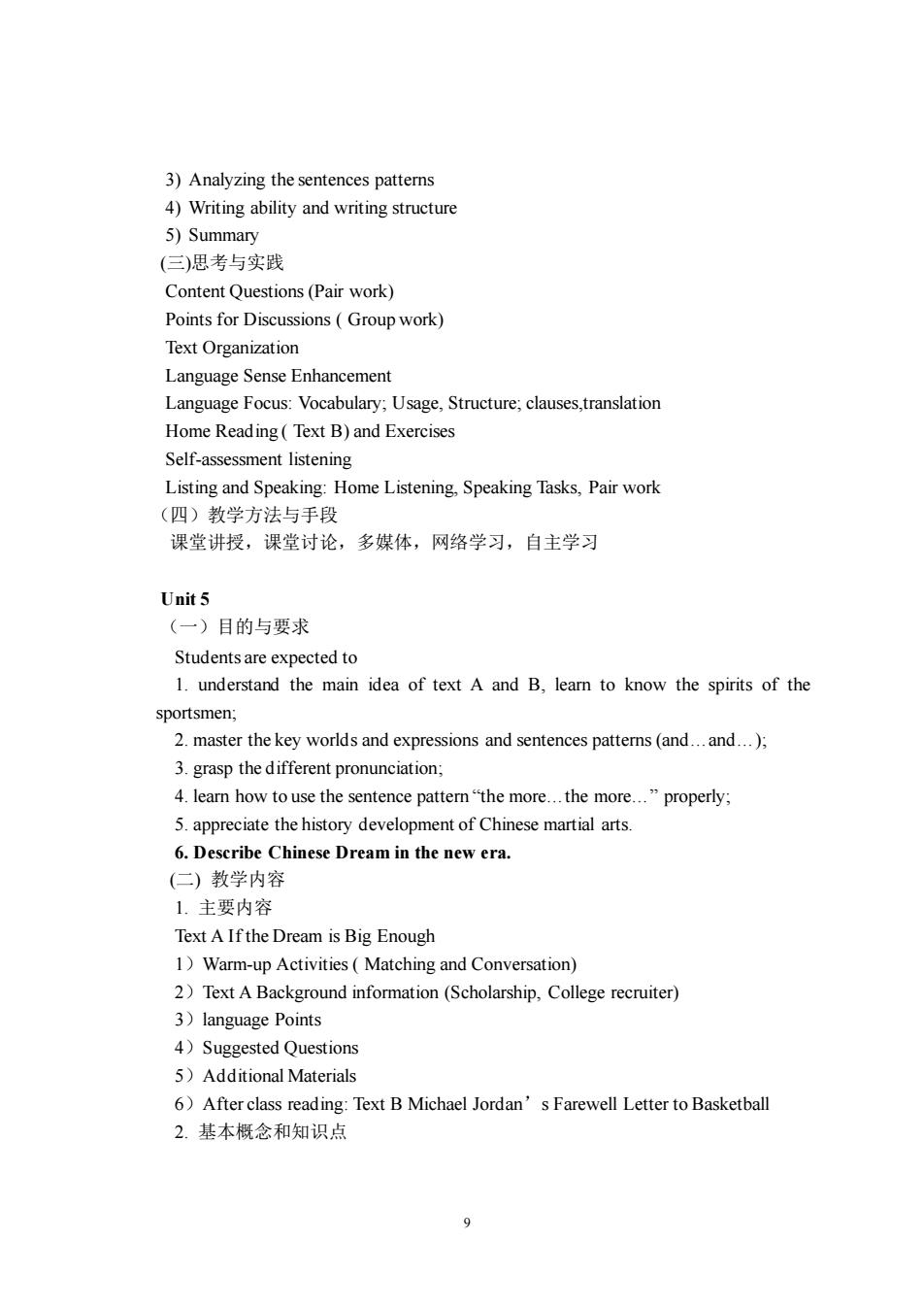
3)Analyzing the sentences patters 4)Writing ability and writing structure 5)Summary (三)思考与实践 Content Questions(Pair work) Points for Discussions(Group work) Text Organization Language Sense Enhancement Language Focus:Vocabulary:Usage,Structure;clauses,translation Home Reading(Text B)and Exercises Self-assessment listening Listing and Speaking:Home Listening,Speaking Tasks,Pair work (四)教学方法与手段 课堂讲授,课堂讨论,多媒体,网络学习,自主学习 Unit 5 (一)目的与要求 Studentsare expected to 1.understand the main idea of text A and B,leamn to know the spirits of the sportsmen; 2.master the key worlds and expressions and sentences patterns(and...and...); 3.grasp the different pronunciation; 4.learn how to use the sentence pattern"the more...the more..."properly: 5.appreciate the history development of Chinese martial arts. 6.Describe Chinese Dream in the new era. (二)教学内容 1.主要内容 Text A Ifthe Dream is Big Enough 1)Warm-up Activities(Matching and Conversation) 2)Text A Background information(Scholarship.College recruiter) 3)language Points 4)Suggested Questions 5)Additional materials 6After class reading:Text B Michael Jordan's Farewell Letter to Basketball 2.基本概念和知识点
9 3) Analyzing the sentences patterns 4) Writing ability and writing structure 5) Summary (三)思考与实践 Content Questions (Pair work) Points for Discussions ( Group work) Text Organization Language Sense Enhancement Language Focus: Vocabulary; Usage, Structure; clauses,translation Home Reading ( Text B) and Exercises Self-assessment listening Listing and Speaking: Home Listening, Speaking Tasks, Pair work (四)教学方法与手段 课堂讲授,课堂讨论,多媒体,网络学习,自主学习 Unit 5 (一)目的与要求 Students are expected to 1. understand the main idea of text A and B, learn to know the spirits of the sportsmen; 2. master the key worlds and expressions and sentences patterns (and…and…); 3. grasp the different pronunciation; 4. learn how to use the sentence pattern “the more…the more…” properly; 5. appreciate the history development of Chinese martial arts. 6. Describe Chinese Dream in the new era. (二) 教学内容 1. 主要内容 Text A If the Dream is Big Enough 1)Warm-up Activities ( Matching and Conversation) 2)Text A Background information (Scholarship, College recruiter) 3)language Points 4)Suggested Questions 5)Additional Materials 6)After class reading: Text B Michael Jordan’s Farewell Letter to Basketball 2. 基本概念和知识点
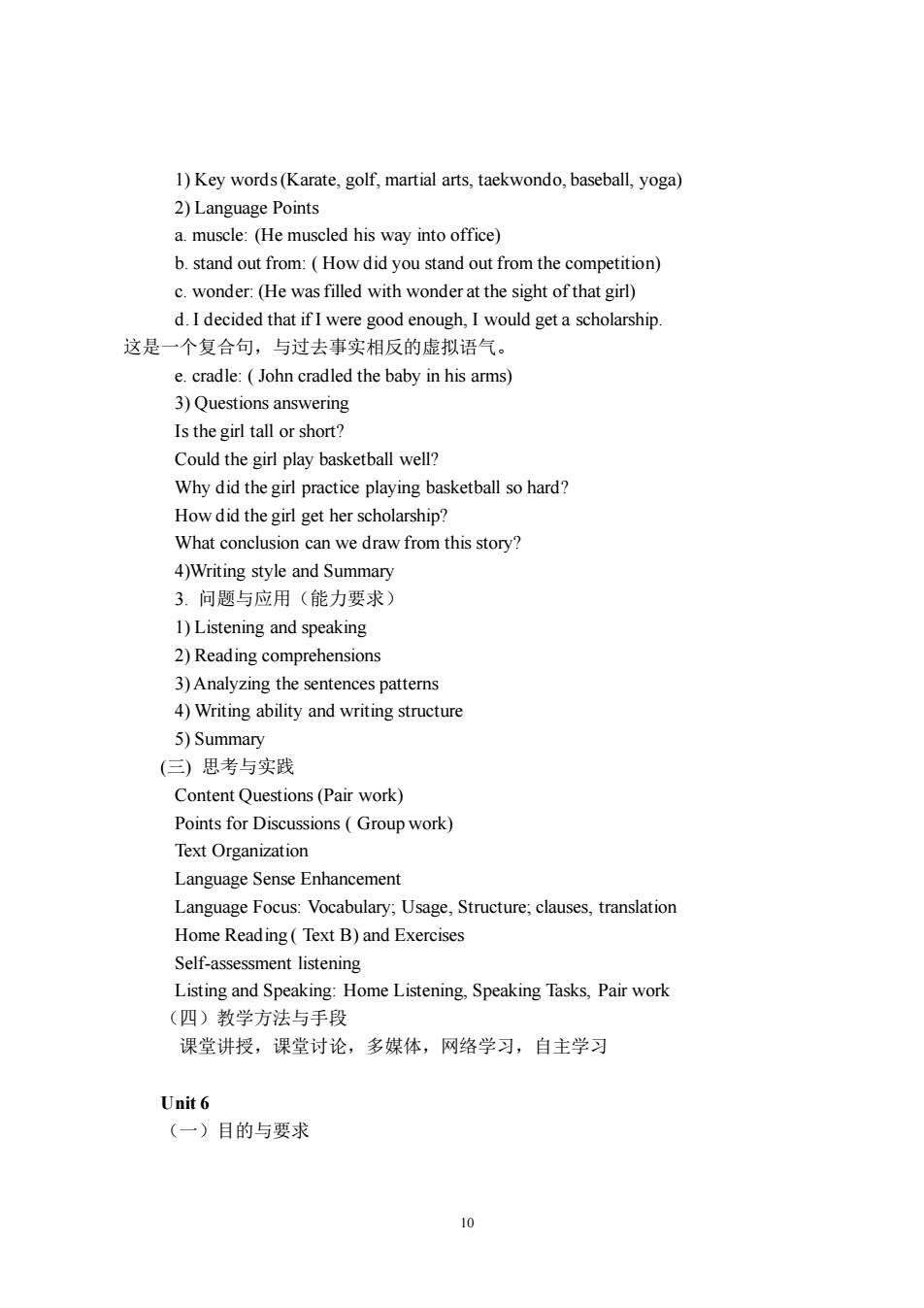
1)Key words(Karate,golf,martial arts,taekwondo,baseball,yoga) 2)Language Points a.muscle:(He muscled his way into office) b.stand out from:(How did you stand out from the competition) c.wonder:(He was filled with wonder at the sight of that girl) d.I decided that if I were good enough,I would geta scholarship 这是一个复合句,与过去事实相反的虚拟语气。 e.cradle:John cradled the baby in his arms) 3)Questions answering Is the girl tall or short? Could the girl play basketball well? Why did the girl practice playing basketball so hard? How did the girl get her scholarship? What conclusion can we draw from this story? 4)Writing style and Summary 3.问题与应用(能力要求) 1)Listening and speaking 2)Reading comprehensions 3)Analyzing the sentences patters 4)Writing ability and writing structure 5)Summary (三)思考与实践 Content Questions(Pair work) Points for Discussions(Group work) Text Organization Language Sense Enhancement Language Focus:Vocabulary:Usage,Structure;clauses,translation Home reading Text b)and exercises Self-assessment listening Listing and Speaking:Home Listening,Speaking Tasks,Pair work (四)教学方法与手段 课堂讲授,课堂讨论,多媒体,网络学习,自主学习 Unit6 (一)目的与要求 10
10 1) Key words (Karate, golf, martial arts, taekwondo, baseball, yoga) 2) Language Points a. muscle: (He muscled his way into office) b. stand out from: ( How did you stand out from the competition) c. wonder: (He was filled with wonder at the sight of that girl) d. I decided that if I were good enough, I would get a scholarship. 这是一个复合句,与过去事实相反的虚拟语气。 e. cradle: ( John cradled the baby in his arms) 3) Questions answering Is the girl tall or short? Could the girl play basketball well? Why did the girl practice playing basketball so hard? How did the girl get her scholarship? What conclusion can we draw from this story? 4)Writing style and Summary 3. 问题与应用(能力要求) 1) Listening and speaking 2) Reading comprehensions 3) Analyzing the sentences patterns 4) Writing ability and writing structure 5) Summary (三) 思考与实践 Content Questions (Pair work) Points for Discussions ( Group work) Text Organization Language Sense Enhancement Language Focus: Vocabulary; Usage, Structure; clauses, translation Home Reading ( Text B) and Exercises Self-assessment listening Listing and Speaking: Home Listening, Speaking Tasks, Pair work (四)教学方法与手段 课堂讲授,课堂讨论,多媒体,网络学习,自主学习 Unit 6 (一)目的与要求